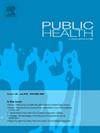Healthcare access among people with and without disabilities: a cross-sectional analysis of the National Socioeconomic Survey of Chile
IF 3.9
3区 医学
Q1 PUBLIC, ENVIRONMENTAL & OCCUPATIONAL HEALTH
引用次数: 0
Abstract
Objectives
There is a lack of data on health inequities experienced by people with disabilities in Chile. Hence, this study aimed to compare healthcare utilization, coverage, and barriers to accessing health services among people with and without disabilities in Chile.
Study design
Secondary cross-sectional study.
Methods
We analysed data of the 2022 National Socioeconomic Survey of Chile. People with disabilities were identified based on the Washington Group Questions. Multivariable logistic regressions were performed to compare the indicators of utilization, coverage, and barriers to accessing healthcare between people with versus without disabilities. Adjusted odds ratios (aOR) were reported with 95 % confidence intervals (95 % CI).
Results
A total of 192,666 participants were included in the study; persons with disabilities represented 10 % of the sample (n = 21,769). People with disabilities were more likely to have had a health problem (aOR, 2·22; 95 % CI, 2·12-2·32) and more frequently used any type of health consultation, than those without disabilities. The coverage of adult health check-ups (aOR, 0·88; 95 % CI, 0·81-0·96) and Pap tests among women (aOR, 0·76; 95 % CI, 0·70-0·82), were lower among those with disabilities. Reports of experiencing any barrier to accessing healthcare were more common among people with disabilities.
Conclusions
People with disabilities in Chile continue to experience health inequities, both in terms of higher healthcare needs and lower coverage, and various barriers to accessing healthcare. Thus, a disability lens needs to be mainstreamed in the health system to leave no one behind.
求助全文
约1分钟内获得全文
求助全文
来源期刊

Public Health
医学-公共卫生、环境卫生与职业卫生
CiteScore
7.60
自引率
0.00%
发文量
280
审稿时长
37 days
期刊介绍:
Public Health is an international, multidisciplinary peer-reviewed journal. It publishes original papers, reviews and short reports on all aspects of the science, philosophy, and practice of public health.
 求助内容:
求助内容: 应助结果提醒方式:
应助结果提醒方式:


